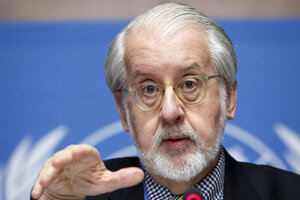Humanitarian aid is the best, and only, solution for Syria
The US and international community have run out of other options for addressing Syria’s bloody civil war. Greater humanitarian assistance can have a stabilizing effect, brings factions together, and paves the way for future cooperation. Without it, broken societies never mend.

Brazilian Paulo Sergio Pinheiro, chairman of the Commission of Inquiry on Syria, speaks during a press conference prior to the presentation of the commission's report on Syria to the 25th session of the Human Rights Council at the United Nations in Geneva March 5.
Salvatore Di Nolfi/Keystone/AP
Washington
Three years ago this March the Arab Spring came to Syria. Unlike revolutions in neighboring Egypt, Tunisia, and Libya, Syria’s revolution has dragged on in a horrific way: 100,000 dead, 2.5 million refugees, 6.5 million internally displaced within Syria.
Today there is little food, little hope, and few choices for the international community to help stop the bloodshed. Strategic, coordinated humanitarian assistance remains the best opportunity for meeting the urgent needs of Syria’s people but also resolving the conflict. Aid has the potential to bring together competing factions inside and outside Syria and can pave the way for future diplomatic cooperation. Increased humanitarian aid is also likely to have a stabilizing effect on Syria over both the short and long term. And it brings needed witnesses to atrocities the world must be made aware of.
The United States and international community have run out of other options for addressing Syria’s bloody civil war.
Military options are not feasible, at least not a US military intervention. After the searing experiences of Iraq and Afghanistan, there is little political will among the American public or its allies for boots on the ground. Moreover, policymakers remember what happened the last time the US used force in Syria’s neighborhood. The result in Lebanon in the 1980s was a deadly attack on a US installation that left 241 marines dead.
A grand political bargain is not in the cards. The most recent window for high-level diplomacy closed in Geneva thanks to Russian intransigence, Chinese passivity, and a Syrian opposition in Switzerland that could not speak for the Syrian opposition in Syria. Small diplomatic breakthroughs are possible with limited cease-fires, but a major international agreement ending the Syrian conflict is unlikely at this point.
Arming the opposition in Syria poses too many difficulties. The idea may have merits, but the obstacles at this point are too great: discerning who and where the opposition is and ensuring that good forces get the weapons, not the Islamist extremist elements, both of which are now commingled in the fog of war.
Relief agencies are the best diplomats
Humanitarian assistance is therefore the best “solution.” It distributes responsibility among governments, nongovernmental organizations, relief agencies, and individual donors. It creates a rare sense of unity of purpose, in part because all sides take advantage of it. In the case of Syria, relief organizations may be the best diplomats to negotiate opening borders to bring in lifesaving humanitarian convoys.
There are several keys to ensuring that humanitarian assistance succeeds:
1. The US government will have to continue negotiating with Iran and Russia to open humanitarian corridors in Syria.
2. Nations must follow through with their aid pledges. The United Nations has appealed for $6.5 billion, only a fraction of which has actually been provided, according to Amnesty International.
3. Conditions in refugee camps must be improved – not just for humanitarian reasons. On national security grounds alone, there is a case for ensuring the health and well-being of refugees in Lebanon, Jordan, Turkey, Iraq, and Egypt. Syrian refugees will eventually leave these squalid quarters and return home or find more permanent residence elsewhere. They will remember how donor nations treated them.
4. A campaign is needed to ramp up American donations to Syria. The US Agency for International Development reports that the US government has spent just $1.7 billion in assistance since the start of the conflict. The public can open wider their hearts and wallets, too. Donations for Syria pale in comparison with those for the Indian Ocean tsunami, though millions more have been affected.
5. Congress will need to consider how to allow more than a trickle of Syrian refugees seeking asylum into the US.
Don’t let Syria become Somalia
Humanitarian assistance, as a response to a crisis, always risks backlash from those who argue that it prolongs conflict to the benefit of authoritarian regimes or that extremists will abuse the aid. But in prolonged civil wars, aid can have a stabilizing effect. Conversely, without it, broken societies never mend. A Syria that resembles Somalia, with no infrastructure, rule of law, or expertise, is not a good outcome.
What the world has learned from Rwanda and other civil wars is that large-scale displacement of populations leaves countries devoid of talent. Millions of Syrian children are not in school – a lost generation of Syrian youth, too many of whom could end up with no place to turn but extremism. Also lost in Syria are artwork, paintings, sculptures, and other vital pieces of culture, history, and memory.
Lastly, when humanitarian corridors are created, they enable critical outside access – eyes and ears on the ground to bear witness to things the world never wants to see but must.
If the goal is a peaceful, stable, secure Syria, the US and international community have to address the wounds of today so that building that future does not become harder and more expensive, and take longer.
Tara Sonenshine is a distinguished fellow at George Washington University and an adviser to the Berlin-based Institute for Cultural Diplomacy. She was formerly executive vice president of the United States Institute of Peace and served as undersecretary of State for Public Diplomacy and Public Affairs.

